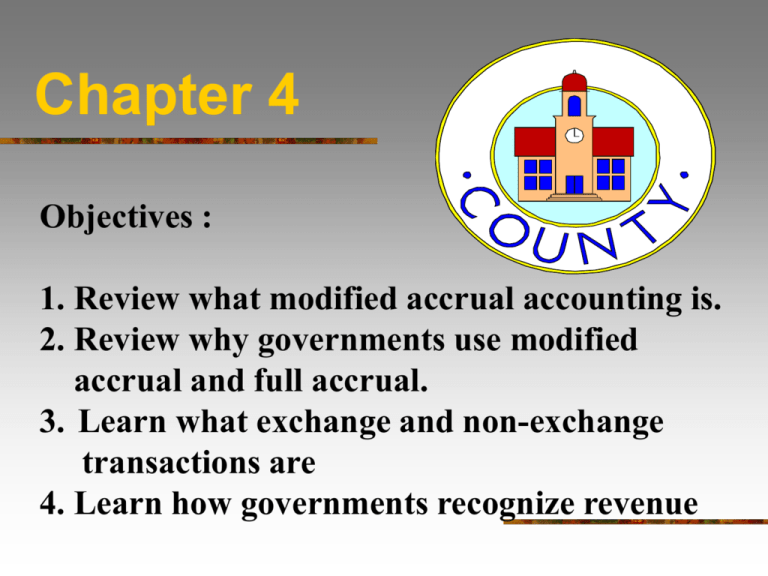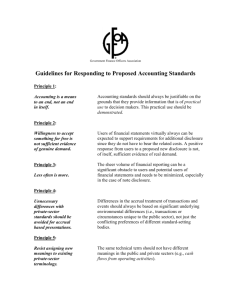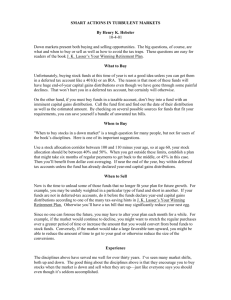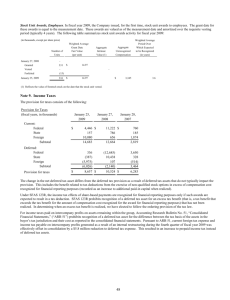ch4 - Cal State LA - Instructional Web Server
advertisement

Chapter 4 Objectives : 1. Review what modified accrual accounting is. 2. Review why governments use modified accrual and full accrual. 3. Learn what exchange and non-exchange transactions are 4. Learn how governments recognize revenue Why Modified Accrual? • Provides information about interperiod equity • Whether the entity obtained and used its resources as specified in the budget Modified Accrual Modified accrual accounts for expendable financial resources, loosely interpreted as current assets and current liabilities. Revenue is recognized when measurable and available. Expenditures are recognized when the goods or services are obtained. Used for governmental fund statements only. Measurable & Available Since revenue is not “earned” some other criteria must be used. Governments can command resources or are granted resources through programs. Therefore, availability through assessment or grant is the key event. No dollars can be recorded unless the amounts can be reasonably estimated or measured. So measurable and available are the criteria. Transactions Exchange Where value is given by both sides to the transaction Examples: Charges for services Licenses Fees Permits Inspection charges In Proprietary funds Non-Exchange Imposed taxes Derived tax revenues Government mandated Voluntary transactions Can be constrained by time or use What types of revenue • Property taxes • Sales taxes • Income taxes • Donations • Grants • Restricted • Shared • Unrestricted • Entitlements • Gains/losses • Interest and dividends • Fees and licenses • Fines Property Taxes Based on the value of the real estate within a municipality’s boundaries. A mil rate, established based on the budget, is assessed against the value of real estate. The mil rate times the assessed value equals the property tax due. May be revisions for homeowners, seniors, or because of negotiations with businesses. California Property Taxes CALIFORNIA Capped at 1¼ % of purchase price Indexed for inflation by no more than 2% Values change on change of ownership Time Line • Budget prepared • Establish tax rate • Allocated to individual properties/owners • Billed and estimates of uncollectible taxes • Collected • Delinquent recognition 60 Day Rule Because measurable is the criteria for recognition, governments feel that monies collected within 60 days of the end of the fiscal year are “available” in the current fiscal year. Fiscal year end 60 days ___Taxes assessed________________________________________Some cash collected_______________ Revenue Recognized Entries Levied: Property taxes receivable 1,000 Deferred Property tax revenue 985 Allowance for uncollectible 15 Deferred because at the time the taxes are levied it is not apparent that the revenue will be available in the current fiscal year. Entries Collect $750 of the $1,000 assessed: Cash Property Taxes Receivable 750 Deferred Property Tax revenue Property Tax revenue 750 750 750 Entries, con’t 60 Day rule: Deferred Property Tax revenue 175 Property Tax revenue 175 Note: Since the books usually aren’t closed until 60 days after the end of the fiscal year, municipalities know this number. When collected: Cash 175 Property Taxes Receivable 175 This leaves $75 as yet uncollected. Entries Reclassify as delinquent: Property taxes receivable- delinquent 75 Property taxes receivable 75 Note: This isn’t necessarily at the end of the fiscal year, it could be just after the taxes are finally due. Entries, con’t Collect delinquent: Cash 15 Property Taxes-rec delinquent 15 Deferred property Tax 15 Property Tax revenue 15 Entries, Con’t Collect after two months into new fiscal year: Cash 10 Deferred property tax revenue 10 Property Taxes Rec. Delinquent 10 Property Tax revenue 10 Since this is after the 60 day rule, must recognize the revenue. Write Offs Write Offs of property taxes use a similar process as write offs under FASB rules: Allowance for uncollectible 15 Property Taxes Receivable Delinquent 15 Sales Taxes •Assessed on the value of goods and services purchased • Even though taxes may not be received until the state receives and reallocates taxes, an entity can recognize the revenue when the state has the money but has not yet remitted to the municipality. Sales Taxes receivable 100 Sales tax revenue 100 Government-wide statements doesn’t have to meet “available” criterion Income Taxes • Similar recognition as sales taxes, 60 day rule • Estimate late collections based on historical experience • Make sure to recognize as revenue in the correct year. • For government-wide statements, income taxes don’t have to meet “available” criterion! Grants • Restricted • Unrestricted • Contingent • Donations • Entitlements • Shared revenues •PILOT Unrestricted grants Unrestricted both time and purpose, recognize when grant declared assuming funds “available” Unrestricted as to purpose but time restriction, Cash 10,000 Deferred revenue 10,000 Recognize revenue in time period to which the grant is restricted. Restricted Grants • Restricted to a specific purpose • Revenue not recognized until expended for the purpose intended for the grant, called “expenditure driven” Grants in Special Revenue Fund Because the whole fund is restricted, the government can recognize the revenue when the grant is received Cash 150,000 Grant Revenue 150,000 Entries Restricted Grants Recognize grant to the extent it is spent when cash received and committed: Cash 350,000 Grant Receivable 50,000 Revenue from Grants 400,000 Entries, General Fund If declared and not yet expended but will be: Grant receivable 100,000 Deferred rev. from grant 100,000 Do not recognize as revenue until funds expended. When expenditures take place: Deferred grant revenue 100,000 Grant revenue 100,000 Cash Received First Cash 50,000 Deferred Revenue Expenditure 20,000 Cash Deferred Revenue 20,000 Grant Revenue 50,000 20,000 20,000 Contingent Grants Grant contingent on entity doing something Recognize grant to the extent that contingency fulfilled. Example: “I’ll award $1 million if you collect a similar amount” As collections take place, Grant receivable 500,000 Grant revenue 500,000 Donations If donation of fixed assets for use: No recognition except in schedule of assets If asset will be held for sale:(GF) Asset held for sale 10,000 Revenue from donation 10,000 When fixed assets sold: (GF) Cash 7,500 OFS - sale of asset 7,500 Fund Balance 10,000 Asset held for sale 10,000 (On government-wide statements all fixed assets are recognized and revenue would be recognized) Entitlements Items such as food stamps, Medicare. Expenditure driven recognition, i.e. recognize revenue at the same time as expenditure is recognized. Expenditures 10,000 Revenue 10,000 If “inventory” of entitlement items exists: Inventory 5,000 Deferred revenue 5,000 Shared Revenues Revenues collected by one level of government but shared with another. An example, sales taxes, vehicle taxes • Recognize when available Payments in lieu of taxes When a tax exempt entity pays an amount to another instead of paying property taxes An example would be when a foreign mission in Los Angeles or San Francisco pays something to the city. The foreign missions would be tax exempt, so would not pay property taxes. This reimburses the city for the services provided. Sale of Fixed Assets Government fund Take off schedule of fixed assets No gains or losses in governmental fund Cash 5,000 OFS 5,000 Government-wide Would report gains and losses Use FASB rules Gains and Losses • For Gov’ts investments are “marked to market” • But do not follow the three categories of investments (held for sale, trading, and held to maturity) •Gains and losses, both realized and unrealized are recognized and gains & losses are reported on the statement of activities. •For governments mark to fair value and recognize the difference as an increase/decrease to the investment account • Applies to both fund and government-wide statements Interest and Dividends • On long term investments, recognize increases in value as a debit to the investment account and a credit to increase in fair value • On short term investments, amortize the discount or premium and recognize as income. Both methods increase fund balance by the increase in value of the investments. Same for both governmental and governmentwide funds. Fines Recognition when entity can legally claim Because fines may be protested, usually means when paid or judgment entered to pay Not available in current year, then deferred revenue Government-wide statements recognition not subject to available test Fees and Licenses • Exchange transaction • Even if intended to cover several years or the annual payment covers parts of two fiscal years, the revenue is recognized when the cash is received. This is because the fees are usually not refundable. • Government-wide statements recognized over the period of the license Full Accrual Use for Government-wide statements To achieve interperiod equity and report on all economic resources, government-wide statements use full accrual Includes long term assets Includes long term debt Recognizes depreciation In general follows FASB rules. Property Taxes Government-wide The “available” criterion doesn’t have to be met Recognize revenue at time of levy Adjusted for uncollectibles Subject to budget constraints Review Know how governments recognize different types of revenue Property Taxes Sales taxes Income taxes Grants Gains and Losses Fees and Licenses Fines





